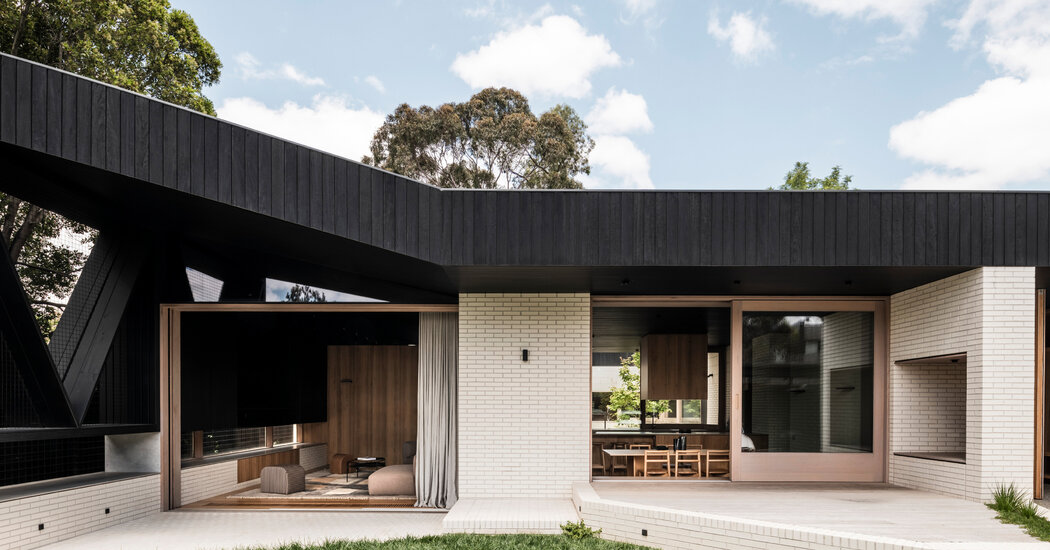
[ad_1]
As the real estate market in Melbourne, Australia, sizzled and home prices surged in 2017, Chris Calleja and Joy Suemag were scrambling to find a larger house for their young family.
“Property was hot, so you had to be brave and go in and bid at auction,” said Mr. Calleja, 47, who works in finance at the Ford Motor Company. “You’re going to all these places and losing, losing, losing.”
So when he and Ms. Suemag, also 47 and a marketing and sales professional at Ford, found a 1950s house in the Melbourne suburb of Alphington, which they liked for its proximity to work, school, stores and restaurants, they didn’t hesitate — although it was far from perfect.
“It was run-down and would have been cheaper to demolish than fix up,” Mr. Calleja said. “We said, ‘Let’s buy it and tear it down.’”
At least, that was the plan. After striking a deal to buy the house for 1.7 million Australian dollars (about $1.1 million), they and their children — Mali, now 11, and Mark, 9 — moved in temporarily and began looking for an architect.
Once they had unpacked, they noticed one big problem right away, beyond the poor insulation and the possums living in the roof: The primary living spaces in the back of the house and the backyard were dark, while the front of the house got sun all day long.
“We wanted to have a lot of light, and in Australia that means a lot of northern sun,” Mr. Calleja said. “But if you’ve got street frontage on the north and want to have all your windows there, you have privacy concerns.”
Creating an internal courtyard was one possible solution. Searching online, the couple found FIGR, a Melbourne-based architecture studio that had recently designed a striking courtyard house nearby.
When Adi Atic and Michael Artemenko, the founders of FIGR, visited the 0.16-acre lot, they agreed that building a house with a courtyard would help. But they also thought they could do better than simply replace the old house with a new one. Looking at how the backyard was hemmed in by other houses, Mr. Artemenko said, the architects asked themselves: “Why don’t we flip this on its head and do the front yard as the backyard?”
By pushing the new house as far back as the lot-line setback requirement would allow, they could create a more generous, light-filled yard in front. But privacy would still be an issue, and neither the owners nor their architects wanted to put up a big fence.
That’s when Mr. Atic and Mr. Artemenko remembered learning about the concept of a ha-ha in architecture school: a sunken fence used in 18th-century landscapes that was concealed from view. “Basically, it looks like a ditch, and it prevented livestock from going in the garden area,” Mr. Atic said.
The architects turned this idea on its head, too: Rather than digging a ditch, they would build a landscaped earthen mound near the sidewalk, blocking sightlines from the street and creating a garden-like feeling in the yard.
For the house, they designed a 2,750-square-foot, single-story structure that runs in a circle around a central courtyard and oversized glass doors that open entire walls to the outdoors. For cladding, they chose slender white brick and charred silvertop ash that run from the exterior into interior rooms, reinforcing the sense of indoor-outdoor living.
Once the plans were set, the family moved into a rental down the street as demolition of the old house and construction of the new one began in July 2020. They had already ordered most of their building materials at the beginning of the pandemic, before supply-chain issues snarled other construction projects, so their new home was complete in November 2021 at a cost of about 1.5 million Australian dollars (about $990,000).
The kitchen, dining area and living room are at the front of the house, taking advantage of the northern light and views of the expanded front garden. In the middle of the house are two bedrooms for the children on one side of the courtyard and a home office on the other. The primary bedroom is at the back, along with an additional sitting room and a gym; all have views of the rear garden, where the old backyard used to be.
“When you’re in this property, you feel very secluded; you feel like you’re in the country,” Mr. Atic said. “You see greenery everywhere, even though you’re five minutes from the city.”
The windows around the courtyard help the family stay connected. “We can see the kids from the kitchen, through the courtyard,” Ms. Suemag said, so they don’t need to call out to find each other. “That’s probably my favorite thing.”
The reimagined front yard has also been embraced by the family — including their golden Labrador, Mellow, who keeps her distance from the earthen mound. “She doesn’t climb the ha-ha,” Mr. Calleja said. “She did once, when it was being constructed, but we arranged the boulders so she couldn’t.”
Much like the 18th-century ha-ha that kept farm animals where they were supposed to be, this 21st-century version has proved useful for restraining an urban pet. “It does the job,” Mr. Calleja said.
For weekly email updates on residential real estate news, sign up here.
[ad_2]
Source link






